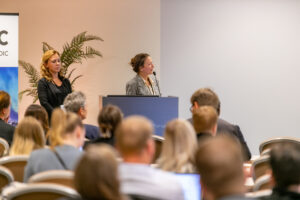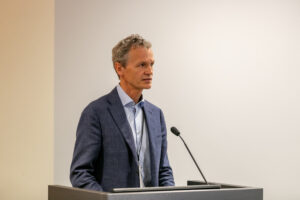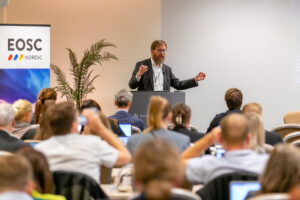The Final Event: Session: The added value of regional collaborations and how this can support EOSC
Intergovernmental Collaboration in the Nordics, Senior Advisor Cecilia Leveaux and Signe van Zundert, Nordic Council of Ministers, Digital
First, the event counted with the participation of Signe Van Zundert and Cecilia Leveaux, from the Nordic Council of Ministers. Founded in 1971, it has a strong vision in mind for the next 8 years: making the Nordic region the most sustainable and integrated region in the world.
Signe Van Zundert pointed out that the green transition of our societies, the achievement of carbon-neutral and sustainable circular and bio-based economies, is only possible through innovation and digital integration. Only with this in mind, we could create a socially sustainable Nordic Region.
On the importance of digitalisation and digital integration, Cecilia Leveaux introduced the Council for Digitalisation, and explained its 2022-2024 priorities for the Nordic-Baltic region.
The first is increasing mobility and integration in the Nordic and Baltic region by building a common area for digital services. The second, promoting sustainable development in the Nordic-Baltic region through data-driven innovation, data-sharing and open data. Last but not least, its third goal is to promote Nordic leadership in the EU-/EEa and globally on digital transformation of society in a sustainable and inclusive manner.
For achieving these goals it is key to establish strong Nordic-Baltic cooperation. Its added value, she mentioned, is clear: Nordic-Baltic countries are a forerunner in digitalisation, therefore establishing early-stage areas of cooperation can bring very fruitful results, finding innovative solutions to common challenges. By strengthening these first lines of cooperation, the region can build up a higher level of trust, creating the base for future collaborations.

Image: Cecilia Leveaux & Signe van Zundert. Photo by Gertrud Alatare.
The presentation available in the Knowledge Hub
The Nordic e-Infrastructure Collaboration (NeIC), Gudmund Høst, NeIC Director
Collaboration also means sharing resources. In this sense, the Nordic e-Infrastructure Collaboration, the NeIC, plays a key role in the region. NeIC is an initiative of six national service providers. Overall, it works with a network of 200 experts and 45 partners.
Its director, Gudmund Høst, pointed out that NeIC is currently working on a framework for collaboration so that in the future Nordic-Baltic countries will have a better way of sharing resources. Its unique workflow, involving few but very strong partners, makes decision-making quicker and more flexible. This system allows NeIC to be a key partner for establishing cross-border collaboration on digital infrastructure, becoming a regional sandbox for EOSC.

Image: Gudmund Høst. Photo by Gertrud Alatare.
The presentation available in the Knowledge Hub
NORDUnet: the Nordic Gateway for Research and Education, Lars Fischer, Strategy & Policy Officer
His presentation was followed by NORDUnet, another key partner for EOSC in the region. NORDUnet is a regional collaboration between the National research and education networks in the Nordic countries. Its Strategy and Policy Officer, Lars Fischer, affirmed that what makes Nordic cooperation successful is that the research environment is small, compared to other regions and countries, which makes it easier to have a common understanding and consensus to move forward.
On the collaboration between NORDUnet and EOSC, he explained that the main role of NORDUnet is to make sure that when researchers are looking for data, they can find it in the right place. In this sense, NORDUnet acts as the Nordic gateway for research and education. The added value of the collaboration with EOSC is the input they receive from the research community, in order to improve processes.

Image: Lars Fischer. Photo by Gertrud Alatare.